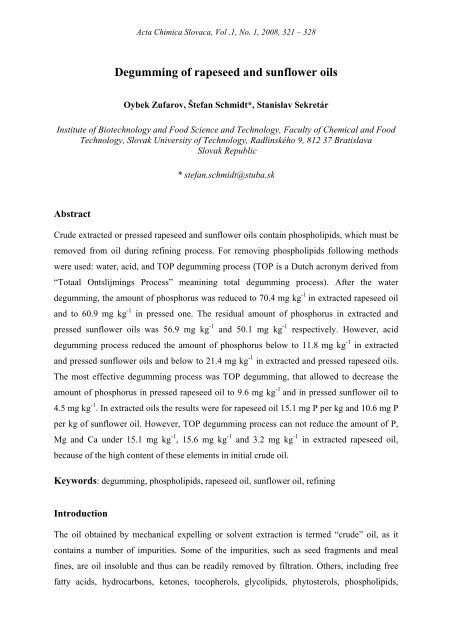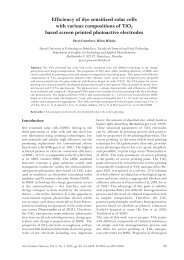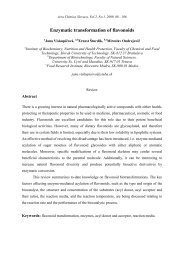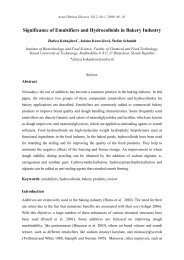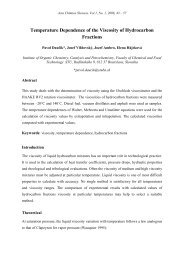Degumming of rapeseed and sunflower oils - Acta Chimica Slovaca
Degumming of rapeseed and sunflower oils - Acta Chimica Slovaca
Degumming of rapeseed and sunflower oils - Acta Chimica Slovaca
Create successful ePaper yourself
Turn your PDF publications into a flip-book with our unique Google optimized e-Paper software.
<strong>Acta</strong> <strong>Chimica</strong> <strong>Slovaca</strong>, Vol .1, No. 1, 2008, 321 – 328<br />
<strong>Degumming</strong> <strong>of</strong> <strong>rapeseed</strong> <strong>and</strong> <strong>sunflower</strong> <strong>oils</strong><br />
Oybek Zufarov, Štefan Schmidt*, Stanislav Sekretár<br />
Institute <strong>of</strong> Biotechnology <strong>and</strong> Food Science <strong>and</strong> Technology, Faculty <strong>of</strong> Chemical <strong>and</strong> Food<br />
Technology, Slovak University <strong>of</strong> Technology, Radlinského 9, 812 37 Bratislava<br />
Slovak Republic<br />
Abstract<br />
* stefan.schmidt@stuba.sk<br />
Crude extracted or pressed <strong>rapeseed</strong> <strong>and</strong> <strong>sunflower</strong> <strong>oils</strong> contain phospholipids, which must be<br />
removed from oil during refining process. For removing phospholipids following methods<br />
were used: water, acid, <strong>and</strong> TOP degumming process (TOP is a Dutch acronym derived from<br />
“Totaal Ontslijmings Process” meanining total degumming process). After the water<br />
degumming, the amount <strong>of</strong> phosphorus was reduced to 70.4 mg kg -1 in extracted <strong>rapeseed</strong> oil<br />
<strong>and</strong> to 60.9 mg kg -1 in pressed one. The residual amount <strong>of</strong> phosphorus in extracted <strong>and</strong><br />
pressed <strong>sunflower</strong> <strong>oils</strong> was 56.9 mg kg -1 <strong>and</strong> 50.1 mg kg -1 respectively. However, acid<br />
degumming process reduced the amount <strong>of</strong> phosphorus below to 11.8 mg kg -1 in extracted<br />
<strong>and</strong> pressed <strong>sunflower</strong> <strong>oils</strong> <strong>and</strong> below to 21.4 mg kg -1 in extracted <strong>and</strong> pressed <strong>rapeseed</strong> <strong>oils</strong>.<br />
The most effective degumming process was TOP degumming, that allowed to decrease the<br />
amount <strong>of</strong> phosphorus in pressed <strong>rapeseed</strong> oil to 9.6 mg kg -1 <strong>and</strong> in pressed <strong>sunflower</strong> oil to<br />
4.5 mg kg -1 . In extracted <strong>oils</strong> the results were for <strong>rapeseed</strong> oil 15.1 mg P per kg <strong>and</strong> 10.6 mg P<br />
per kg <strong>of</strong> <strong>sunflower</strong> oil. However, TOP degumming process can not reduce the amount <strong>of</strong> P,<br />
Mg <strong>and</strong> Ca under 15.1 mg kg -1 , 15.6 mg kg -1 <strong>and</strong> 3.2 mg kg -1 in extracted <strong>rapeseed</strong> oil,<br />
because <strong>of</strong> the high content <strong>of</strong> these elements in initial crude oil.<br />
Keywords: degumming, phospholipids, <strong>rapeseed</strong> oil, <strong>sunflower</strong> oil, refining<br />
Introduction<br />
The oil obtained by mechanical expelling or solvent extraction is termed “crude” oil, as it<br />
contains a number <strong>of</strong> impurities. Some <strong>of</strong> the impurities, such as seed fragments <strong>and</strong> meal<br />
fines, are oil insoluble <strong>and</strong> thus can be readily removed by filtration. Others, including free<br />
fatty acids, hydrocarbons, ketones, tocopherols, glycolipids, phytosterols, phospholipids,
322<br />
O.Zufarov et al., <strong>Degumming</strong> <strong>of</strong> <strong>rapeseed</strong> <strong>and</strong> <strong>sunflower</strong> <strong>oils</strong><br />
proteins, pigments, <strong>and</strong> resins, are soluble or form stable colloidal suspensions in the oil. Most<br />
<strong>of</strong> these have unfavorable effects on the flavor, odor, appearance, <strong>and</strong> shelf life <strong>of</strong> the oil, <strong>and</strong><br />
therefore have to be removed from the vegetable <strong>oils</strong> by chemical or physical refining<br />
processes (Verleyen et al. 2002). The common <strong>oils</strong>eeds as soybean, cottonseed, <strong>sunflower</strong> <strong>and</strong><br />
<strong>rapeseed</strong> are rich sources <strong>of</strong> phospholipids (Indira et al. 2000; Willem et al. 2008).<br />
Phospholipids pose many problems for the storage <strong>and</strong> processing <strong>of</strong> the crude oil <strong>and</strong> are<br />
removed from oil during refining by a process known as degumming (Brekke 1975).<br />
There are two types <strong>of</strong> phospholipids: hydratable (HPL) <strong>and</strong> nonhydratable (NHPL),<br />
<strong>and</strong> they are removed from oil by the degumming process. Most <strong>of</strong> the phospholipids in crude<br />
<strong>sunflower</strong> <strong>and</strong> <strong>rapeseed</strong> <strong>oils</strong> are hydratable <strong>and</strong> can be removed by water degumming (Carelli<br />
et al. 1997). NHPL are not hydratable with water, can not swell <strong>and</strong> form gels or precipitate<br />
from oil (Szydlowska-Czerniak 2007). Removing <strong>of</strong> NHPL requires more complex process at<br />
increased temperature with the use <strong>of</strong> phosphoric acid, citric acid or other degumming<br />
substances.<br />
The phosphatidyl choline <strong>and</strong> phosphatidyl inositol are completely hydratable.<br />
Phosphatidyl ethanolamine is only partly <strong>and</strong> phosphatidic acid is not hydratable, when they<br />
form salt with divalent cation (mainly calcium <strong>and</strong> magnesium) or when they are not in<br />
dissociated form. The simplified chemistry is the following: the phosphatide/metal complexes<br />
are decomposed by addition <strong>of</strong> acid or complexing agent, then follows hydratation <strong>of</strong><br />
phospholipids by water. Partial neutralisation <strong>of</strong> acid is applied to avoid migration <strong>of</strong><br />
phosphatides back to the oil phase (Kovari 2004).<br />
However, for physical refining <strong>of</strong> vegetable <strong>oils</strong>, water degumming is not sufficient, so<br />
degumming process plays a critical role at physical refining <strong>of</strong> edible <strong>oils</strong>. Traditional<br />
degumming processes, including water degumming, superdegumming, TOP degumming, acid<br />
treatment <strong>and</strong> other ones, cannot guarantee the achievement <strong>of</strong> low phosphorus contents<br />
required for physical refining, <strong>and</strong> they are not always optimally suited for all oil qualities<br />
because <strong>of</strong> the high content <strong>of</strong> NHPL (Copel<strong>and</strong> et al. 2005).<br />
The “total degumming process,” known by its Dutch acronym TOP, is designed to<br />
further treat the oil that has already been water degummed. The process has two variations to<br />
cater to different needs (Dijkstra et al.1987). In the first approach a dilute acid is finely<br />
dispersed into the oil. After a sufficient contact time a base is added <strong>and</strong> mixed into the acidin-oil<br />
dispersion. Such a base can be NaOH, sodium carbonate or sodium silicate. During the<br />
process the acid initially decomposes metal/phosphatidic acid (PA) complexes into insoluble<br />
metal salts <strong>and</strong> PA (in acid form). Phosphatidic acid is then hydrated by partial neutralisation<br />
<strong>Acta</strong> <strong>Chimica</strong> <strong>Slovaca</strong>, Vol .1, No. 1, 2008, 321 – 328
O.Zufarov et al., <strong>Degumming</strong> <strong>of</strong> <strong>rapeseed</strong> <strong>and</strong> <strong>sunflower</strong> <strong>oils</strong><br />
with the base added, <strong>and</strong> removed from the oil by centrifugation. The second approach uses a<br />
combination <strong>of</strong> two centrifuges to remove the hydrated phospholipids with high efficiency<br />
<strong>and</strong> minimal losses. The first one removes the bulk <strong>of</strong> the gum phase. Clearly, the quality <strong>of</strong><br />
the water-degummed oil is critical to TOP degumming. When the water-degummed oil has a<br />
higher Ca/Mg content, TOP process becomes less effective (Cleenewerck et al. 1992).<br />
Removal <strong>of</strong> phospholipids from vegetable <strong>oils</strong> by using membrane techniques is the<br />
one <strong>of</strong> the modern technologies (Ochoa et al. 2001). The latest degumming processes are s<strong>of</strong>t<br />
degumming <strong>and</strong> enzymatic degumming. S<strong>of</strong>t degumming process involves a complete<br />
elimination <strong>of</strong> phospholipids by a chelating agent, such as ethylenediaminetetraacetic acid<br />
(EDTA), in the presence <strong>of</strong> emulsifying agent. Different kind <strong>of</strong> crude <strong>oils</strong> were degummed<br />
by S<strong>of</strong>t degumming method; the content <strong>of</strong> phospholipids in the treated samples <strong>of</strong> the <strong>oils</strong><br />
studied was lowered approximately to 5 mg kg -1 . However, the high cost <strong>of</strong> EDTA could not<br />
allow use this method in industry (Choukri et al. 2001). Nowadays, two kinds <strong>of</strong> enzymes,<br />
such as Lecitase 10L (pancreatic phospholipase A2) <strong>and</strong> Lecitase Novo (microbial lipase), are<br />
used for oil degumming in the industry (Yang et al. 2006; Bo et al. 2006).<br />
The aim <strong>of</strong> this article is the study <strong>of</strong> influence <strong>of</strong> water, acid <strong>and</strong> TOP degumming on<br />
the amount <strong>of</strong> P, Mg <strong>and</strong> Ca in <strong>rapeseed</strong> <strong>and</strong> <strong>sunflower</strong> <strong>oils</strong> respectively.<br />
Experimental<br />
Materials<br />
Crude industrial <strong>rapeseed</strong> <strong>and</strong> <strong>sunflower</strong> <strong>oils</strong> were processed from Slovakian <strong>oils</strong>eed<br />
cultivars in Palma-Tumys Bratislava (Slovak Republic).<br />
Methods<br />
The acid value <strong>of</strong> the <strong>oils</strong> was determined according to AOCS Official Method Cd 3a -<br />
63 (AOCS, 1997). The amount <strong>of</strong> phospholipids was determined as the total phosphorus <strong>of</strong><br />
vegetable oil according to AOCS Official Method Ca 12-55 (AOCS, 1997). The absorbance<br />
was read at 650 nm using UV/VIS-1601 spectrophotometer (Shimadzu, Tokyo, Japan), <strong>and</strong><br />
the phosphorus content was determined by means <strong>of</strong> st<strong>and</strong>ard curve using NaH2PO4 as a<br />
st<strong>and</strong>ard. The amount <strong>of</strong> calcium <strong>and</strong> magnesium were determined by inductively coupled<br />
plasma (ICP) optical emission spectroscopy (V Liberty 200, Victoria, Australia) by following<br />
AOCS <strong>of</strong>ficial method Ca 17-01 (AOCS, 1997). Magnetic stirrer (IKA Werk, Staufen im<br />
<strong>Acta</strong> <strong>Chimica</strong> <strong>Slovaca</strong>, Vol .1, No. 1, 2008, 321 – 328<br />
323
324<br />
O.Zufarov et al., <strong>Degumming</strong> <strong>of</strong> <strong>rapeseed</strong> <strong>and</strong> <strong>sunflower</strong> <strong>oils</strong><br />
Breisgau, Germany), <strong>and</strong> centrifuge (MPW-340, CHEMARGO, Blachownia, Pol<strong>and</strong>)<br />
operated at 1300 x g, were used during the all experiments. All measurements were repeated<br />
three times; the mean values <strong>and</strong> the respective st<strong>and</strong>ard deviations were reported.<br />
Water degumming<br />
Crude <strong>rapeseed</strong> <strong>and</strong> <strong>sunflower</strong> <strong>oils</strong> were degummed by heating the <strong>oils</strong> to 80 °C,<br />
mixed with water (to 5% vol.) <strong>and</strong> stirred for 15 min by magnetic stirrer. Then, the mixture<br />
was centrifuged for 20 minutes.<br />
Acid degumming<br />
Crude <strong>rapeseed</strong> <strong>and</strong> <strong>sunflower</strong> <strong>oils</strong> were heated to 80 °C <strong>and</strong> water solution <strong>of</strong> citric<br />
acid (30 %) was then added in amount <strong>of</strong> 2 % (by volume <strong>of</strong> the oil). The mixture was stirred<br />
for 20 minutes. The oil/acid mixture was kept at 80 °C up to 15 min, cooled down to 25 °C,<br />
mixed with water (1 %) <strong>and</strong> transferred to a holding vessel. After settling for 60 min the<br />
mixture was centrifuged for 20 min to separate acid degummed oil from its by-products.<br />
TOP degumming<br />
TOP degumming process consists <strong>of</strong> two-stage process: 1 - water degumming <strong>of</strong> crude<br />
oil; 2 - water-degummed oil was heated to 80 °C <strong>and</strong> was initially mixed intensively with a<br />
phosphoric acid (14 %) in amount <strong>of</strong> 0.1 % by weight <strong>of</strong> oil. After a short reaction time (for<br />
approximately 5 min), the acid is partially neutralized with NaOH (20 % water solution) in<br />
amount <strong>of</strong> 0.3 % by weight <strong>of</strong> oil. The total reaction times were 10 minutes. The phosphatides<br />
that are hydrated by this way are removed by centrifugation for 20 min to obtain oil with low<br />
content <strong>of</strong> phospholipids, Ca <strong>and</strong> Mg.<br />
Statistical analysis<br />
All measurements were performed in triplicate. The statistical analysis was carried out<br />
with the program Statgraphics Plus, Version 1.4 for Windows (Manugistic, Rockville, USA).<br />
The significance <strong>of</strong> differences between mean values <strong>of</strong> all measurements were determined at<br />
the p = 0.05 (5%) level, using a one way analysis <strong>of</strong> the variance <strong>and</strong> the t-test.<br />
<strong>Acta</strong> <strong>Chimica</strong> <strong>Slovaca</strong>, Vol .1, No. 1, 2008, 321 – 328
Results <strong>and</strong> Discussion<br />
O.Zufarov et al., <strong>Degumming</strong> <strong>of</strong> <strong>rapeseed</strong> <strong>and</strong> <strong>sunflower</strong> <strong>oils</strong><br />
<strong>Degumming</strong> process removes impurities like phospholipids, gums, residual metals, Ca<br />
<strong>and</strong> Mg from crude vegetable <strong>oils</strong>. The present alkali metals, such Ca <strong>and</strong> Mg are bound on<br />
NHPL. These substances are thermally unstable, they are altered <strong>and</strong> decomposed at increased<br />
temperatures, <strong>and</strong> deteriorate the color <strong>and</strong> overall appearance <strong>of</strong> the oil. For demonstration <strong>of</strong><br />
the efficiency <strong>of</strong> individual steps the amounts <strong>of</strong> phosphorus, Ca <strong>and</strong> Mg were determined<br />
after every degumming operation.<br />
Water degumming<br />
During the water degumming HPL react with water, form gels <strong>and</strong> are separated by<br />
centrifugation. After the water degumming the amount <strong>of</strong> total phospholipids (it is expressed<br />
as mg <strong>of</strong> phosphorus per kg <strong>of</strong> oil) decreased from 863.6 mg kg -1 to 70.4 mg kg -1 <strong>of</strong> P in<br />
<strong>rapeseed</strong> extracted oil <strong>and</strong> from 156.4 mg kg -1 to 60.9 mg kg -1 in pressed one (Table 1). In<br />
extracted <strong>and</strong> pressed <strong>sunflower</strong> <strong>oils</strong>, the amount <strong>of</strong> phosphorus also significantly decreased<br />
from 293.5 mg kg -1 to 56.9 mg kg -1 <strong>and</strong> from 95.7 mg kg -1 to 50.1 mg kg -1 respectively. In<br />
addition to, the amount <strong>of</strong> Ca <strong>and</strong> Mg was also reduced (Table 2 <strong>and</strong> Table 3).<br />
Table 1. Influence <strong>of</strong> water, citric acid <strong>and</strong> TOP degumming on phosphorus removal from<br />
crude <strong>rapeseed</strong> <strong>and</strong> <strong>sunflower</strong> <strong>oils</strong><br />
Vegetable <strong>oils</strong><br />
Phosphorus in <strong>oils</strong> (mg kg -1 )<br />
Rapeseed oil Sunflower oil<br />
Extracted Pressed Extracted Pressed<br />
Crude oil 863.6 ± 9.3 156.4 ± 6.2 293.5 ± 7.8 95.7 ± 4.3<br />
Water degummed 70.4 ± 1.2 60.9 ± 1.8 56.9 ± 1.7 50.1 ± 1.1<br />
Acid degummed 21.4 ± 1.5 16.9 ± 1.2 11.8 ± 1.7 7.1 ± 1.1<br />
TOP degummed 15.1 ± 1.1 9.6 ± 0.9 10.6 ± 1.3 4.5 ± 0.9<br />
Despite lowered values <strong>of</strong> P, Mg <strong>and</strong> Ca in examined <strong>oils</strong>, these amounts are still<br />
unsuitable for physical refining, so these <strong>oils</strong> must be directed to the next technological steps<br />
before the final physical refining.<br />
<strong>Acta</strong> <strong>Chimica</strong> <strong>Slovaca</strong>, Vol .1, No. 1, 2008, 321 – 328<br />
325
326<br />
Acid degumming<br />
O.Zufarov et al., <strong>Degumming</strong> <strong>of</strong> <strong>rapeseed</strong> <strong>and</strong> <strong>sunflower</strong> <strong>oils</strong><br />
The efficient degumming process should convert the NHPL into HPL, which can be<br />
removed from vegetable <strong>oils</strong>. Citric acid is used not only for decomposition <strong>of</strong> metal salt but<br />
also as a chelating agent to keep the metals in water-soluble complex (Katalin 2004).<br />
In comparing with simple water degumming, the acid degumming has lowered the<br />
amount <strong>of</strong> phosphorus in <strong>rapeseed</strong> <strong>and</strong> <strong>sunflower</strong> <strong>oils</strong> (Table 1). After the acid degumming,<br />
the amounts <strong>of</strong> Ca <strong>and</strong> Mg were also reduced in both <strong>oils</strong>. Acid degummed, extracted <strong>and</strong><br />
pressed <strong>rapeseed</strong> <strong>oils</strong> contained 19.9 mg kg -1 <strong>and</strong> 9.7 mg kg -1 <strong>of</strong> Ca in comparing with initial<br />
amount <strong>of</strong> 181.2 mg kg -1 <strong>and</strong> 78.3 mg kg -1 <strong>of</strong> Ca. The amount <strong>of</strong> Mg in <strong>rapeseed</strong> extracted<br />
<strong>and</strong> pressed <strong>oils</strong> are also decreased under to 10.3 mg kg -1 from initial amount 92.2 mg kg -1 <strong>and</strong><br />
25.6 mg kg -1 , respectively (Table 2 <strong>and</strong> Table 3). The amount <strong>of</strong> phosphorus in extracted <strong>and</strong><br />
pressed <strong>sunflower</strong> <strong>oils</strong> decreased from 293.5 mg kg -1 to 11.8 mg kg -1 <strong>and</strong> from 95.7 mg kg -1 to<br />
7.1 mg kg -1<br />
Table 2. Influence <strong>of</strong> water, citric acid <strong>and</strong> TOP degumming on Ca removal from crude<br />
<strong>rapeseed</strong> <strong>and</strong> <strong>sunflower</strong> <strong>oils</strong><br />
Vegetable <strong>oils</strong><br />
Ca in <strong>oils</strong> (mg kg -1 )<br />
Rapeseed oil Sunflower oil<br />
Extracted Pressed Extracted Pressed<br />
Crude oil 181.2 ± 7.4 78.3 ± 4.6 74.9 ± 6.7 26.0 ± 2.2<br />
Water degummed 69.3 ± 1.8 58.4 ± 2.9 34.4 ± 4.3 12.9 ± 1.8<br />
Acid degummed 19.9 ± 1.2 9.7 ± 1.4 9.3 ± 2.1 4.1 ± 1.2<br />
TOP degummed 15.6 ± 1.7 5.1 ± 1.1 4.1 ± 1.2 0.9 ± 0.2<br />
Moreover, the residual content <strong>of</strong> Ca <strong>and</strong> Mg was lower than 9.3 mg kg -1 in extracted<br />
<strong>and</strong> pressed <strong>sunflower</strong> <strong>oils</strong>. Sunflower oil degummed by citric acid can be directed to the next<br />
steps <strong>of</strong> refining process for improving oil color <strong>and</strong> removing <strong>of</strong> FFA (free fatty acids).<br />
However, extracted <strong>rapeseed</strong> oil can not be refined by physical refining process because <strong>of</strong> the<br />
relatively high content <strong>of</strong> P, Ca <strong>and</strong> Mg. This oil can cause complication at the further<br />
refining steps, as bleaching <strong>and</strong> deodorization.<br />
<strong>Acta</strong> <strong>Chimica</strong> <strong>Slovaca</strong>, Vol .1, No. 1, 2008, 321 – 328
TOP degumming<br />
O.Zufarov et al., <strong>Degumming</strong> <strong>of</strong> <strong>rapeseed</strong> <strong>and</strong> <strong>sunflower</strong> <strong>oils</strong><br />
Rapeseed <strong>and</strong> <strong>sunflower</strong> <strong>oils</strong> after water treatment were mixed with phosphoric acid, which<br />
interact with phosphorus in NHPL. Then NaOH was added to the mixture <strong>and</strong> stirred, <strong>and</strong><br />
whole mixture was directed to centrifugation process. Together with NHPL also Ca <strong>and</strong> Mg<br />
are partly removed from vegetable <strong>oils</strong>. According to the table 1, after TOP degumming the<br />
amount <strong>of</strong> phosphorus decreased to 15.1 mg kg -1 in <strong>rapeseed</strong> extracted oil <strong>and</strong> to 9.1 mg kg -1<br />
in pressed one. Experiments showed that the TOP degumming process reduced the amount <strong>of</strong><br />
phosphorus to 10.6 mg kg -1 <strong>and</strong> to 4.5 mg kg -1 in extracted <strong>and</strong> pressed <strong>sunflower</strong> oil.<br />
Table 3. Influence <strong>of</strong> water, citric acid <strong>and</strong> TOP degumming on Mg removal from crude<br />
<strong>rapeseed</strong> <strong>and</strong> <strong>sunflower</strong> <strong>oils</strong><br />
Vegetable <strong>oils</strong><br />
Mg in <strong>oils</strong> (mg kg -1 )<br />
Rapeseed oil Sunflower oil<br />
Extracted Pressed Extracted Pressed<br />
Crude oil 92.2 ± 4.6 25.6 ± 2.3 80.6 ± 4.8 18.4 ± 1.7<br />
Water degummed 41.4 ± 3.3 15.3 ± 1.3 29.0 ± 2.9 6.5 ± 1.2<br />
Acid degummed 12.3 ± 1.4 9.7 ± 1.9 7.3 ± 1.1 2.3 ± 1.3<br />
TOP degummed 3.2 ± 1.1 1.7 ± 0.8 1.6 ± 0.6 0.5 ± 0.1<br />
After TOP degumming process, the amount <strong>of</strong> Ca <strong>and</strong> Mg in <strong>rapeseed</strong> pressed oil<br />
decreased to 4.2 mg kg -1 <strong>and</strong> 1.1 mg kg -1 . The residual amount <strong>of</strong> Ca <strong>and</strong> Mg in extracted<br />
<strong>sunflower</strong> oil was 4.1 mg kg -1 <strong>and</strong> 1.6 mg kg -1 after the TOP degumming (Table 2 <strong>and</strong> Table<br />
3). Pressed <strong>and</strong> extracted <strong>sunflower</strong> <strong>oils</strong> degummed by TOP degumming have the minimal<br />
amount <strong>of</strong> phosphorus, Ca <strong>and</strong> Mg, which allows to shift these <strong>oils</strong> to the next step <strong>of</strong> refining<br />
process. However, extracted <strong>rapeseed</strong> oil has still relatively high amount <strong>of</strong> P <strong>and</strong> Ca in<br />
comparison with the other ones. With a “good” water degummed oil as the starting material,<br />
the residual P level is low as 5 mg kg -1 (for pressed <strong>sunflower</strong> oil) <strong>and</strong> can be achieved low<br />
Mg level (
328<br />
O.Zufarov et al., <strong>Degumming</strong> <strong>of</strong> <strong>rapeseed</strong> <strong>and</strong> <strong>sunflower</strong> <strong>oils</strong><br />
<strong>and</strong> extracted <strong>sunflower</strong> oil. After TOP degumming process, the residual amount <strong>of</strong> P, Mg<br />
<strong>and</strong> Ca in extracted <strong>rapeseed</strong> oil was relatively high. The efficiency <strong>of</strong> degumming process is<br />
directly connected with obtaining methods <strong>of</strong> crude vegetable <strong>oils</strong>. For increasing the<br />
efficiency <strong>of</strong> degumming process, we suggest decreasing the amount <strong>of</strong> P, Mg <strong>and</strong> Ca in an<br />
extracted oil by its mixing with pressed one.<br />
Acknowledgement<br />
This project was supported by the Scientific Grant Agency (VEGA) <strong>of</strong> the Ministry <strong>of</strong><br />
Education <strong>of</strong> the Slovak Republic <strong>and</strong> the Slovak Academy <strong>of</strong> Sciences (Grant No. 1/0746/08)<br />
<strong>and</strong> by the Slovak Research <strong>and</strong> Development Agency under the Contract No. APVV-0310-06.<br />
References<br />
Careli AA, Brevedan MIV, Crapiste GH (1997) Journal <strong>of</strong> the American Oil Chemists’<br />
Society 74: 511-514.<br />
American Oil Chemists’ Society. (1997). Official methods <strong>and</strong> recommended practices <strong>of</strong> the<br />
AOCS (5th ed.). Champaign: AOCS Press.<br />
Brekke OL (1975). In H<strong>and</strong>book <strong>of</strong> Soy Oil Processing (Ed) Oil <strong>Degumming</strong> <strong>and</strong> Soybean<br />
Lecithin, <strong>and</strong> Utilization. Vol 1 (pp 71-78). American Soybean Association, St. Louis, <strong>and</strong><br />
American Oil Chemists’ Society, Champaign, Illinois.<br />
Bo Y, Yong-Hua W, Ji-Guo Y (2006) Journal <strong>of</strong> the American Oil Chemists’ Society 83:<br />
653-658.<br />
Choukri A, Kinany MA, Gibon V, Tirtiaux AJ (2001) Journal <strong>of</strong> the American Oil Chemists’<br />
Society 78: 1157-1160.<br />
Cleenewerck B, Dijkstra A J (1992) Fat Science Technology 94: 317-322.<br />
Indira TN, Hemavathy J, Khatoon S, Gopala Krisna AG, Bhattacharya (2000) Journal <strong>of</strong> Food<br />
Engineering 43: 83-90.<br />
Copel<strong>and</strong> D, Belcher M W (2005) W. Int. Cl. C11B3/00. U.S. patent 6.844.458.<br />
Yang J, Wang GY, Yang H, Mainda B, Guo GY (2006) Food Technology <strong>and</strong> Biotechnology<br />
44: 101-104.<br />
Dijkstra A J, Opstal M (1987) W. Int. Cl. C11B3/00. U.S. Patent 4.698.185.<br />
Kovari K (2004). Oléagineux Corps Gras Lipides 11: 381-387.<br />
Ochoa N, Pagliero C, Marchese J, Mattea M (2001) Separation <strong>and</strong> Purification<br />
Technology 22: 417-422.<br />
Szydlowska-Czerniak A (2007) Food Chemistry 105: 1179-1187.<br />
Verleyen T, Sosinska U, Ioannidou S, Verhe R, Dewettinck K, Huyghebaert A, Greyt W<br />
(2002) Journal <strong>of</strong> the American Oil Chemists’ Society 79: 947-953.<br />
Willem VN, Mabel CT (2008) European Journal <strong>of</strong> Lipid Science <strong>and</strong> Technology 110: 472-<br />
476.<br />
<strong>Acta</strong> <strong>Chimica</strong> <strong>Slovaca</strong>, Vol .1, No. 1, 2008, 321 – 328


